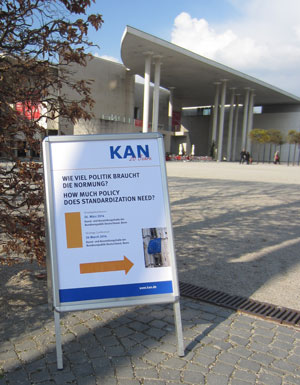KANBrief 2/14

Rarely have discussions been as heated as the negotiations of the Transatlantic Trade and Investment Partnership (TTIP). This is understandable, given that the issue is essentially the elimination of barriers to trade beyond tariffs, i.e. including the creation of common standards. The possible significance for occupational safety and health was one topic at the KAN strategy conference held at the Federal Art and Exhibition Hall in Bonn on the occasion of KAN's 20th anniversary.
Does the free-trade agreement strengthen the role of ISO? This question, which was put to an audience vote electronically both before and after the discussion, was intended to document the opinion-forming nature of the conference. As indeed it did: before the discussion, a majority believed that the TTIP would strengthen international standardization; after the discussion, 54% believed it would not.
Dr Torsten Bahke, Chairman of DIN's Executive Board, was not surprised by this result, given that the bodies of standards on the two sides of the Atlantic are based on very different philosophies. Whereas in Europe, efforts are made to develop a body of standards that is as free of contradictions as possible, no consistent body of standards exists in the USA. But why is this? A brief look at their histories shows that the two private-sector standardization systems have developed in very different directions. Almost 600 standards bodies exist in the USA. The majority are accredited by ANSI (the American National Standardization Institute), which is a member of ISO. ANSI however does not develop standards itself, nor does it have the power to implement ISO standards by withdrawing national standards.
In Europe, purchasers of products are entitled to assume that a manufacturer's EC declaration of conformity means that the EU legislation listed is observed. Their counterparts in the USA receive a declaration of conformity based upon a certification standard. In other words, whereas CE marking in Europe confirms the observance of the general safety objectives of EU "laws", conformity in the US merely means that the product complies with "a standard" – of some kind. This is not comparable with the statutory approach to prevention embodied in the CE product safety mark. Safe products are the goal of those on both sides, however. Furthermore, manufacturers on both sides would appreciate a single standard, with a view to selling their products worldwide. EU experts however are involved at ISO, in the interests of the European and national bodies of standards; conversely, the Americans leave it to the market to determine which standard prevails internationally.
A possible solution: bilateral standards with ISO quality
Now that non-tariff barriers to trade are being eliminated, what solution is now conceivable? Since complete harmonization is likely to remain utopian owing to the differences between the statutory frameworks, Bahke proposes a third way: the development of new, common specifications in innovative fields that have not yet been harmonized. This would however require industry on both sides of the Atlantic to take the initiative. Günther Petrasch, head of Government Affairs at Siemens in Munich, who delivered the economic keynote paper on the TTIP, welcomed this proposal. As a representative of a global company with investment and manufacturing interests not only in the USA, he considered it important that these bilateral results should ultimately lead to an international standard, ideally at ISO-IEC level.
The level of protection in Europe must not be watered down
These bilateral discussions must however not be to the detriment of occupational safety and health in Europe, warned Rüdiger Reitz, who represented the German Social Accident Insurance (DGUV) on the discussion panel. Reitz, head of the DGUV's Product Safety and DGUV Test unit, shared the prevailing view of the audience (65%) that the agreement could have an impact upon occupational safety and health in Europe. He drew attention to the position paper on the TTIP (pdf) of the German Social Accident Insurance, which explicitly lists topics that it considers non-negotiable. "The level of product and workplace safety attained in Europe must not be weakened by the agreement," was how Reitz summarized his demands, a view of the TTIP that is also shared by KAN (See Common Declaration on standardization policy in the field of occupational safety and health).
Karl-Josef Thielen